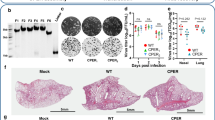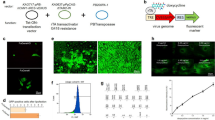Abstract
In the recently developed Semliki Forest virus (SFV) DNA expression system, recombinant RNA encoding the viral replicase, and helper RNA molecules encoding the structural proteins needed for virus assembly are cotransfected into cells. Since the helper RNA lacks the sequence needed for its packaging into nucleocapsids, only recombinant RNAs should be packaged. We have found, however, that small amounts of replication-proficient SFV particles can still be produced. Here we describe the construction of a helper variant with a mutation in the gene encoding the viral spike protein such that its product cannot undergo normal proteolytic processing to activate viral entry functions. Hence, the recombinant stock is noninfectious, but may be activated by cleavage with chymotrypsin. When recombinant virus produced with the new helper was examined in a variety of assays, including sensitive animal tests, we were unable to detect any replication-competent SFV particles. We therefore conclude that this conditional expression system meets extremely stringent biosafety requirements.
This is a preview of subscription content, access via your institution
Access options
Subscribe to this journal
Receive 12 print issues and online access
$209.00 per year
only $17.42 per issue
Buy this article
- Purchase on Springer Link
- Instant access to full article PDF
Prices may be subject to local taxes which are calculated during checkout
Similar content being viewed by others
References
Liljeström, P. 1993. Virally based transient expression systems. Curr. Op. Ther. Pat. 3: 1–27.
Bredenbeek, P.J. and Rice, C.M. 1992. Animal RNA virus expression systems. Sem. Virol. 3: 297–310.
Rice, C.M. 1992. Examples of expression systems based on animal RNA viruses: alphaviruses and influenza virus. Curr. Op. Biotechnol. 3: 522–532.
Schlesinger, S. 1993. Alphaviruses—vectors for the expression of heterologous genes. Trends Biotechnol. 11: 18–22.
Liljeström, P., Lusa, S., Huylebroeck, D. and Garoff, H. 1991. In vitro mutagenesis of a full-length cDNA clone of Semliki Forest virus: the 6,000-molecular-weight membrane protein modulates virus release. J. Virol. 65: 4107–4113.
Liljeström, P. and Garoff, H. 1991. A new generation of animal cell expression vectors based on the Semliki Forest virus replicon. Bio/Technology 9: 1356–1361.
Geigenmüller-Gnirke, U., Weiss, B., Wright, R. and Schlesinger, S. 1991. Complementation between Sindbis viral RNAs produces infectious particles with a bipartite genome. Proc. Nat. Acad. Sci. USA 88: 3253–3257.
Weiss, B.G. and Schlesinger, S. 1991. Recombination between Sindbis virus RNAs. J. Virol. 65: 4017–4025.
Melançon, P. and Garoff, H. 1986. Reinitiation of translocation in the Semliki Forest virus structural polyprotein: Identification of the signal for the E1 glycoprotein. EMBO J. 5: 1551–1560.
Melançon, P. and Garoff, H. 1987. Processing of the Semliki Forest virus structural polyprotein: Role of the capsid protease. J. Virol. 61: 1301–1309.
Garoff, H., Huylebroeck, D., Robinson, A., Tillman, U. and Liljeström, P. 1990. The signal sequence of the p62 protein of Semliki Forest virus is involved in initiation but not in completing chain translocation. J. Cell Biol. 111: 867–876.
Liljeström, P. and Garoff, H. 1991. Internally located cleavable signal sequences direct the formation of Semliki Forest virus membrane proteins from a polyprotein precursor. J. Virol. 65: 147–154.
Wahlberg, J.M., Boere, W.A. and Garoff, H. 1989. The heterodimeric association between the membrane proteins of Semliki Forest virus changes its sensitivity to mildly acidic pH during virus maturation. J. Virol. 63: 4991–4997.
Lobigs, M., Zhao, H. and Garoff, H. 1990. Function of Semliki Forest virus E3 peptide in virus assembly: Replacement of E3 with an artificial signal peptide abolishes spike heterodimerization and surface expression of E1. J. Virol. 64: 4346–4355.
de Curtis, I. and Simons, K. 1988. Dissection of Semliki Forest virus glycoprotein delivery from the trans-Golgi network to the cell surface in permeabilized BHK cells. Proc. Natl. Acad. Sci. USA 85: 8052–8056.
Barr, P.J. 1991. Mammalian subtilisins: The long-sought dibasic processing endoproteases. Cell 66: 1–3.
Smeekens, S.P. 1993. Processing of protein precursors by a novel family of subtilisin-related mammalian endoproteases. Bio/Technology 11: 182–186.
Lobigs, M. and Garoff, H. 1990. Fusion function of the Semliki Forest virus spike is activated by proteolytic cleavage of the envelope glycoprotein p62. J. Virol. 64: 1233–1240.
Lobigs, M., Wahlberg, J.M. and Garoff, H. 1990. Spike protein oligomerization control of Semliki Forest virus fusion. J. Virol. 64: 5214–5218.
Salminen, A., Wahlberg, J.M., Lobigs, M., Liljeström, P. and Garoff, H. 1992. Membrane fusion process of Semliki Forest virus II: Cleavage dependent reorganization of the spike protein complex controls virus entry. J. Cell Biol. 116: 349–357.
Wahlberg, J. and Garoff, H. 1992. Membrane fusion process of Semliki Forest virus I: Low pH-induced rearrangement in spike protein quaternary structure proceeds virus penetration into cells. J. Cell Biol. 116: 339–357.
Wahlberg, J.M., Bron, R., Wilschut, J. and Garoff, H. 1992. Membrane fusion of Semliki Forest virus involves homotrimers of the fusion protein. J. Virol. 66: 7309–7318.
Bron, R., Wahlberg, J.M., Garoff, H. and Wilschut, J. 1993. Membrane fusion of Semliki Forest virus in a model system: correlation between fusion kinetics and structural changes in the envelope glycoprotein. EMBO J. 12: 693–701.
Strauss, J.H. and Strauss, E.G. 1988. Evolution of RNA viruses. Ann. Rev. Microbiol. 42: 657–683.
Griffin, D.E. 1986. Alphavirus pathogenesis and immunity, p. 209–250. In: The Togaviridae and Flaviviridae, S. S. Schlesinger and M. J. Schlesinger (Eds.). Plenum Press, New York.
Mathiot, C.C., Grimaud, G., Garry, P., Bouquety, J.C., Mada, A., Daguisy, A.M. and Georges, A.J. 1990. An outbreak of human Semliki Forest virus infections in Central African Republic. Am. J. Trop. Med. Hyg. 42: 386–393.
Bradish, C.J., Allner, K. and Maber, H.B. 1971. The virulence of original and derived starins of Semliki Forest virus for mice, guineapigs and rabbits. J. Gen. Virol. 12: 141–160.
Glasgow, G.M., Sheahan, B.J., Atkins, G.J., Wahlberg, J.M., Salminen, A. and Liljeström, P. 1991. Two mutations in the envelope glycoprotein E2 of Semliki Forest virus affecting the maturation and entry patterns of the virus alter pathogenicity for mice. Virology 185: 741–748.
Morein, B., Helenius, A., Simons, K., Pettersson, R., Kääriäinen, L. and Schirrmacher, V. 1978. Effective subunit vaccines against an enveloped animal virus. Nature 276: 715–718.
Sambrook, J., Fritsch, E.F., and Maniatis, T. 1989. Molecular Cloning. A Laboratory Manual. Cold Spring Harbor Laboratory Press, Cold Spring Harbor, NY.
Kunkel, T.A., Roberts, J.D. and Zakour, R.A. 1987. Rapid and efficient site-specific mutagenesis without phenotypic selection. Meth. Enzymol. 154: 367–382.
Su, T.-Z. and El-Gewely, M.R. 1988. A multisite-directed mutagenesis using T7 DNA polymerase: application for reconstructing a mammalian gene. Gene 69: 81–89.
Liljeström, P. and Garoff, H. 1993. Expression of proteins using Semliki Forest virus vectors, p. 16.xx.1–16.xx.00. In: Current Protocols in Molecular Biology, F. M. Ausubel, R. Brent, R. E. Kingston, D. D. Moore, J. A. Smith, J. G. Seidman and K. Struhl (Eds.). Greene Publishing Associates and Wiley Interscience, New York.
Author information
Authors and Affiliations
Rights and permissions
About this article
Cite this article
Berglund, P., Sjöberg, M., Garoff, H. et al. Semliki Forest Virus Expression System: Production of Conditionally Infectious Recombinant Particles. Nat Biotechnol 11, 916–920 (1993). https://doi.org/10.1038/nbt0893-916
Received:
Accepted:
Issue Date:
DOI: https://doi.org/10.1038/nbt0893-916



